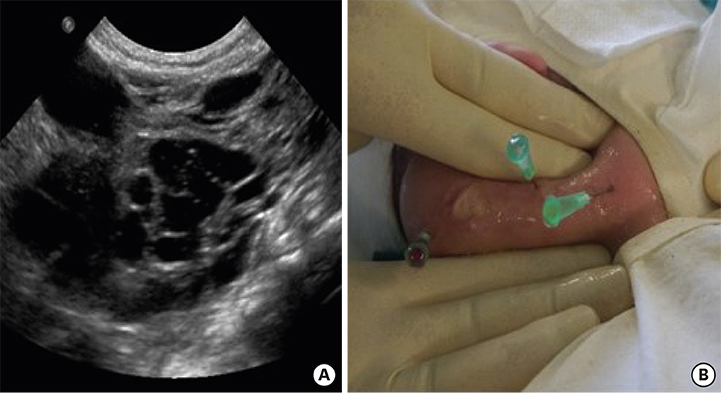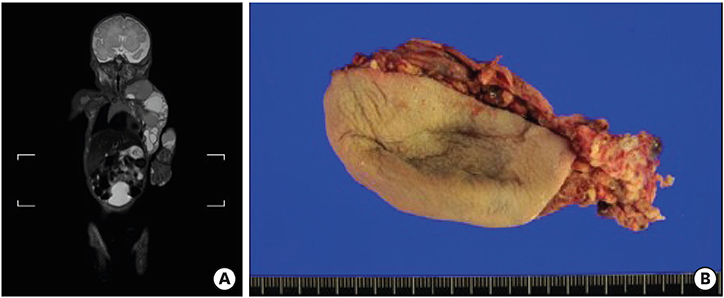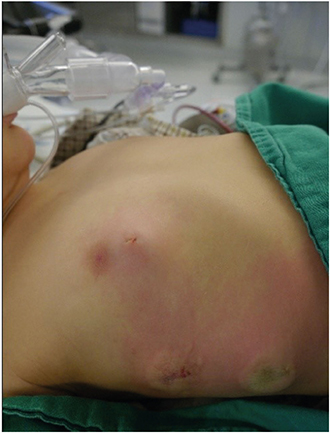Adv Pediatr Surg.
2019 Dec;25(2):44-50. 10.13029/aps.2019.25.2.44.
Early Experience of Doxycycline Sclerotherapy for Lymphatic Malformations
- Affiliations
-
- 1Department of Pediatric Surgery, Chonnam National University Children's Hospital, Gwangju, Korea.
- 2Department of Pediatric Surgery, Asan Medical Center Children's Hospital, University of Ulsan College of Medicine, Seoul, Korea. kimdy@amc.seoul.kr
- KMID: 2466399
- DOI: http://doi.org/10.13029/aps.2019.25.2.44
Abstract
- PURPOSE
Lymphatic malformations (LMs) are congenital malformations of the lymphatic system which can be effectively treated by sclerotherapy. This study aims to evaluate the efficacy of doxycycline in the treatment of LMs.
METHODS
We retrospectively reviewed the medical records of all patients who were diagnosed as LMs and underwent doxycycline sclerotherapy in Asan Medical Center between March 2013 and February 2014. Thirty-five sclerotherapy procedures were performed on 21 patients. The procedures were performed under general anesthesia. After each treatment, the clinical and radiographic response was characterized as complete (≥80% decrease in lesion size), partial (<80% decrease of size), or no response (no decrease of size).
RESULTS
There were 11 male patients and 10 female patients. The median age of sclerotherapy was 21 months (range, 2-180 months). The most common location was cervicofacial (52.3%), followed by extremity (28.6%) and truncal (19.0%). The most common lesion type was macrocystic (71.4%), followed by microcystic (28.5%). There was one (2.8%) skin necrosis which was recovered by wound management. Thirty-eight percent of patients had a complete response, 47.6% of patients had a partial response and 14.3% of patients had no response. Median frequency of treatment was one (range, 1-5). No response group consisted of all microcystic type.
CONCLUSION
Sclerotherapy with Doxycycline is safe and effective for macrocystic LMs.
Keyword
MeSH Terms
Figure
Reference
-
1. Smith RJ. Lymphatic malformations. Lymphat Res Biol. 2004; 2:25–31.
Article2. Elluru RG, Balakrishnan K, Padua HM. Lymphatic malformations: diagnosis and management. Semin Pediatr Surg. 2014; 23:178–185.
Article3. Wiegand S, Eivazi B, Zimmermann AP, Sesterhenn AM, Werner JA. Sclerotherapy of lymphangiomas of the head and neck. Head Neck. 2011; 33:1649–1655.
Article4. Churchill P, Otal D, Pemberton J, Ali A, Flageole H, Walton JM. Sclerotherapy for lymphatic malformations in children: a scoping review. J Pediatr Surg. 2011; 46:912–922.
Article5. Thomas DM, Wieck MM, Grant CN, Dossa A, Nowicki D, Stanley P, et al. Doxycycline sclerotherapy is superior in the treatment of pediatric lymphatic malformations. J Vasc Interv Radiol. 2016; 27:1846–1856.
Article6. Giguère CM, Bauman NM, Sato Y, Burke DK, Greinwald JH, Pransky S, et al. Treatment of lymphangiomas with OK-432 (Picibanil) sclerotherapy: a prospective multi-institutional trial. Arch Otolaryngol Head Neck Surg. 2002; 128:1137–1144.7. Burrows PE, Mitri RK, Alomari A, Padua HM, Lord DJ, Sylvia MB, et al. Percutaneous sclerotherapy of lymphatic malformations with doxycycline. Lymphat Res Biol. 2008; 6:209–216.
Article8. Park JH, Nam SH. The treatment experience of lymphatic malformations in pediatric patients. J Korean Assoc Pediatr Surg. 2018; 24:14–19.
Article9. Fonkalsrud EW. Surgical management of congenital malformations of the lymphatic system. Am J Surg. 1974; 128:152–159.
Article10. Reismann M, Ghaffarpour N, Luvall E, Jirmo AC, Winqvist O, Radtke J, et al. Dynamic Toll-like receptor expression predicts outcome of sclerotherapy for lymphatic malformations with OK-432 in children. J Surg Res. 2014; 187:197–201.
Article11. Molitch HI, Unger EC, Witte CL, vanSonnenberg E. Percutaneous sclerotherapy of lymphangiomas. Radiology. 1995; 194:343–347.
Article12. Cordes BM, Seidel FG, Sulek M, Giannoni CM, Friedman EM. Doxycycline sclerotherapy as the primary treatment for head and neck lymphatic malformations. Otolaryngol Head Neck Surg. 2007; 137:962–964.
Article13. Nehra D, Jacobson L, Barnes P, Mallory B, Albanese CT, Sylvester KG. Doxycycline sclerotherapy as primary treatment of head and neck lymphatic malformations in children. J Pediatr Surg. 2008; 43:451–460.
Article14. Shiels WE 2nd, Kang DR, Murakami JW, Hogan MJ, Wiet GJ. Percutaneous treatment of lymphatic malformations. Otolaryngol Head Neck Surg. 2009; 141:219–224.
Article15. Hurewitz AN, Wu CL, Mancuso P, Zucker S. Tetracycline and doxycycline inhibit pleural fluid metalloproteinases. A possible mechanism for chemical pleurodesis. Chest. 1993; 103:1113–1117.16. Reynolds PM, MacLaren R, Mueller SW, Fish DN, Kiser TH. Management of extravasation injuries: a focused evaluation of noncytotoxic medications. Pharmacotherapy. 2014; 34:617–632.
Article17. Cho BC, Kim JB, Lee JW, Choi KY, Yang JD, Lee SJ, et al. Cervicofacial lymphatic malformations: a retrospective review of 40 cases. Arch Plast Surg. 2016; 43:10–18.
Article18. Kim SY, Lee S, Seo JM, Lim SY. Postoperative adjuvant OK-432 sclerotherapy for treatment of cervicofacial lymphatic malformations: an outcomes comparison. Int J Pediatr Otorhinolaryngol. 2015; 79:570–575.
Article19. Kim DW. OK-432 sclerotherapy of lymphatic malformation in the head and neck: factors related to outcome. Pediatr Radiol. 2014; 44:857–862.
Article20. Yoo JC, Ahn Y, Lim YS, Hah JH, Kwon TK, Sung MW, et al. OK-432 sclerotherapy in head and neck lymphangiomas: long-term follow-up result. Otolaryngol Head Neck Surg. 2009; 140:120–123.
Article21. Won JH, Kim BM, Kim CH, Park SW, Kim MD. Percutaneous sclerotherapy of lymphangiomas with acetic acid. J Vasc Interv Radiol. 2004; 15:595–600.
Article22. Sung MW, Lee DW, Kim DY, Lee SJ, Hwang CH, Park SW, et al. Sclerotherapy with picibanil (OK-432) for congenital lymphatic malformation in the head and neck. Laryngoscope. 2001; 111:1430–1433.
Article23. Sung MW, Chang SO, Choi JH, Kim JY. Bleomycin sclerotherapy in patients with congenital lymphatic malformation in the head and neck. Am J Otolaryngol. 1995; 16:236–241.
Article
- Full Text Links
- Actions
-
Cited
- CITED
-
- Close
- Share
- Similar articles
-
- Percutaneous Drainage and Povidone-Iodine Sclerotherapy of Cervical Lymphatic Malformation
- Lymphatic Malformations of the Orbit
- Therapeutic Effect of Sclerotherapy on Venous Malformations
- Anesthetic Management of Pulmonary Arterial Pressure Change during the Ethanol Sclerotherapy of Peripheral Arteriovenous Malformations
- Transvaginal Direct Puncture and Ethanol Sclerotherapy for Cervicovaginal Venous Malformations: A Case Report and Literature Review




